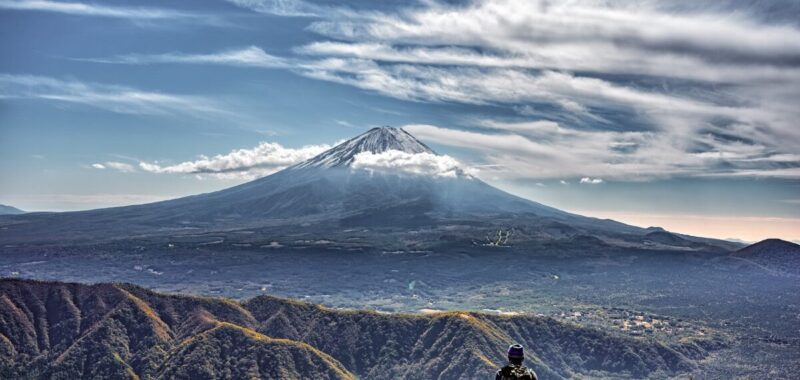The soaring popularity of climbing Japan’s Mount Fuji has sparked overtourism concerns. The Shizuoka Prefectural Government is considering charging climbers JPY 3,000 ($19) to JPY 5,000 ($30) per head starting next summer. The fee is aimed at curbing overcrowding and promoting safety.
The government also plans to restrict overnight climbs from all three trails on the Shizuoka side, except for those with reservations at mountain huts.
Climbing this UNESCO World Heritage site has become a bucket-list activity for both locals and international travelers. During the climbing season from July to September, the trails are often packed with thousands of hikers. This year between early July and early September, around 204,000 people climbed Mt Fuji, and while this marked an 8% drop from the previous year, congestion remains a critical issue.
Entry Regulations and Fees
Yamanashi Prefecture, which shares Mount Fuji with Shizuoka, introduced a daily limit of 4,000 climbers and a fee of JPY 2,000 ($12) per climber earlier this year, significantly reducing nighttime congestion on its trails.
However, Shizuoka did not implement entry regulations and only installed a voluntary registration system.
Shizuoka’s proposed entry fee would replace the current JPY 1,000 ($6) “voluntary conservation fee.”
During a meeting with a local council last week the prefectural government focused on promoting safe climbing of Mount Fuji, while promoting safety measures, such as mandatory prior learning of mountaineering rules.
Japan’s Overtourism Dilemma
Mount Fuji is a small representation of Japan’s overtourism problem. The weak yen and the relaxation of Covid-19 restrictions have driven a record-breaking tourism boom, with over 30 million visitors arriving in the first ten months of 2024 alone, just shy of the pre-pandemic annual record of 31.9 million.
Last month, Japan welcomed a record 3.31 million visitors, up from 2.87 million in September and surpassing July’s monthly record of 3.29 million, according to data from the Japan National Tourism Organization (JNTO).
Japan aims to receive 60 million inbound tourists by 2030.
In the first nine months of this year, travelers spent JPY 5.86 trillion ($37.72 billion), surpassing 2023’s annual record of JPY 5.3 trillion.
While tourism spending is boosting the economy — poised to surpass even electronic components as Japan’s second-largest export sector after the automobile sector — it has also created friction.
From Kyoto’s Geisha district to the shores of Lake Kawaguchi, reports of overcrowding, pollution, and tourist misbehavior have become commonplace. Local communities are now grappling with the balance between economic benefits and preserving their cultural and environmental heritage.
Yes, Overtourism Is a Concern, Say Tourists
Interestingly, travelers themselves are increasingly aware of their impact. A recent joint report by the Japan Tourism Board (JTB) Foundation and the Development Bank of Japan highlights how overtourism is impacting foreign travelers in Japan, with 30% experiencing overcrowding at popular spots. Misbehavior against tourism resources was noted by 13%, while 11% faced accommodation issues.
On a positive note, 63% of visitors said they’re willing to pay extra fees to combat overtourism—up 20% from 2019. Additionally, 70% now prioritize sustainable practices when choosing destinations or hotels.
However, gaps remain between awareness and action, particularly in buying local products at fair prices or avoiding peak times. Still, many travelers are taking steps like donating to preservation efforts, skipping single-use amenities, and limiting unnecessary housekeeping.
Japan’s Counter Measure
Japan isn’t alone in addressing overtourism through fees. European destinations like Venice and Amsterdam have implemented similar measures, with varying degrees of success.
Japan has also experimented with targeted pricing strategies, including higher fees for foreign tourists to counter overtourism concerns.
Some restaurants in Tokyo have also tested two-tier pricing for foreigners and locals.
Earlier this year, Himeji’s mayor proposed raising Himeji Castle’s entry fee from JPY 1,000 ($6) to $30 for foreigners, while locals would pay just $5. The mayor said the extra revenue would help with maintenance and to counter overtourism.
The Hokkaido government plans to move forward with a tourist lodging tax ordinance despite strong local opposition.

